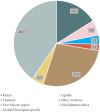Improving risk analysis of the environmental drivers of the spillover, emergence/re-emergence and spread of Crimean-Congo haemorrhagic fever virus, Marburg virus and Middle East respiratory syndrome coronavirus in the East Africa Region
- PMID: 40240055
- PMCID: PMC12004484
- DOI: 10.1136/bmjgh-2025-019162
Improving risk analysis of the environmental drivers of the spillover, emergence/re-emergence and spread of Crimean-Congo haemorrhagic fever virus, Marburg virus and Middle East respiratory syndrome coronavirus in the East Africa Region
Abstract
Introduction: Emerging and/or re-emerging infectious diseases (EIDs) in the East Africa region are associated with climate change-induced environmental drivers. There is a need for a comprehensive understanding of these environmental drivers and to adopt an integrated risk analysis (IRA) framework for addressing a combination of the biological, environmental and socioeconomic factors that increase population vulnerabilities to EID risks to inform biological risk mitigation and cross-sectoral decision-making. The aim of this integrative review was to identify knowledge gaps and contribute to a holistic understanding about the environmental drivers of Crimean-Congo haemorrhagic fever virus (CCHFV), Marburg virus (MARV) and Middle East respiratory syndrome coronavirus (MERS-CoV) infections in the East Africa Region to improve IRA processes at the environment-animal-human exposure interface.
Methods: An integrative review search was carried out to identify relevant studies and reports from 2000 to 2024. Searches were conducted in bibliographic databases and global institutional websites. Inclusion criteria were studies and reports (in English) addressing environmental drivers of CCHFV, MARV and MERS-CoV infections across countries in the East Africa region, existing risk frameworks/methodological tools and/or One Health policy recommendations for risk analysis of environmentally driven biological threats.
Results: Of the total number of studies retrieved from database searches (n=18 075) and website searches (n=44), 242 studies and reports combined were included in the review with the majority covering the environmental drivers (n=137), the risk frameworks/methodological tools (n=73) and the policy recommendations (n=32). We identified 10 categories of environmental drivers, four thematic groups of risk frameworks and three categories of policy recommendations. Overall, many of the included records on the risk frameworks/methodological tools expounded on the adoption of ecological niche modelling (ENM) for environmental monitoring of potential transmission pathways of EIDs and other biological threats.
Conclusion: This integrative review recommends the adoption of specialised risk mapping approaches such as ENM for environmental monitoring of EIDs under IRA processes. Findings from the review were used for the conceptualisation of an IRA framework for addressing environmentally driven EIDs.
Keywords: Environmental health; Global Health; Kenya; Respiratory infections; Viral haemorrhagic fevers.
© World Health Organization 2025. Licensee BMJ.
Conflict of interest statement
Competing interests: None declared.
Figures





Similar articles
-
Widespread exposure to Crimean-Congo haemorrhagic fever in Uganda might be driven by transmission from Rhipicephalus ticks: Evidence from cross-sectional and modelling studies.J Infect. 2022 Dec;85(6):683-692. doi: 10.1016/j.jinf.2022.09.016. Epub 2022 Sep 22. J Infect. 2022. PMID: 36152736
-
Taking forward a 'One Health' approach for turning the tide against the Middle East respiratory syndrome coronavirus and other zoonotic pathogens with epidemic potential.Int J Infect Dis. 2016 Jun;47:5-9. doi: 10.1016/j.ijid.2016.06.012. Epub 2016 Jun 15. Int J Infect Dis. 2016. PMID: 27321961 Free PMC article.
-
Recent advances in understanding Crimean-Congo hemorrhagic fever virus.F1000Res. 2018 Oct 29;7:F1000 Faculty Rev-1715. doi: 10.12688/f1000research.16189.1. eCollection 2018. F1000Res. 2018. PMID: 30416710 Free PMC article. Review.
-
Viral haemorrhagic fevers in the Middle East.Rev Sci Tech. 2019 May;38(1):185-198. doi: 10.20506/rst.38.1.2952. Rev Sci Tech. 2019. PMID: 31564731 Review.
-
Laboratory management of Crimean-Congo haemorrhagic fever virus infections: perspectives from two European networks.Euro Surveill. 2019 Jan;24(5):1800093. doi: 10.2807/1560-7917.ES.2019.24.5.1800093. Euro Surveill. 2019. PMID: 30722811 Free PMC article. Review.
Cited by
-
Recurrent MERS-CoV Transmission in Saudi Arabia- Renewed Lessons in Healthcare Preparedness and Surveillance.J Epidemiol Glob Health. 2025 Jun 2;15(1):77. doi: 10.1007/s44197-025-00426-6. J Epidemiol Glob Health. 2025. PMID: 40455375 Free PMC article. No abstract available.
References
-
- Cohen J, Horne F, Rall K. 'There Is No Time Left': Climate Change, Environmental Threats, and Human Rights in Turkana County. Human rights watch (organization)
Publication types
MeSH terms
Grants and funding
LinkOut - more resources
Full Text Sources
